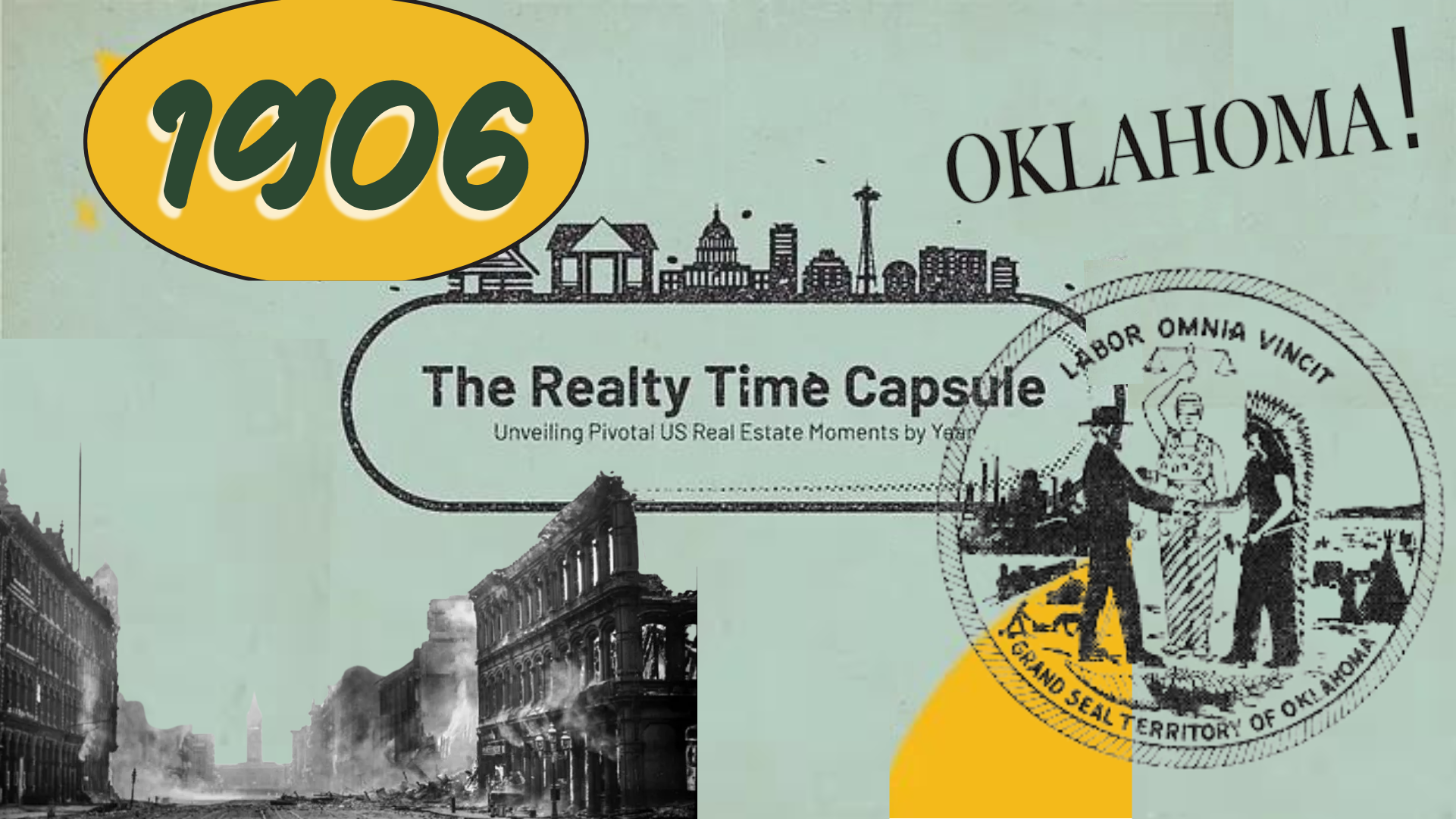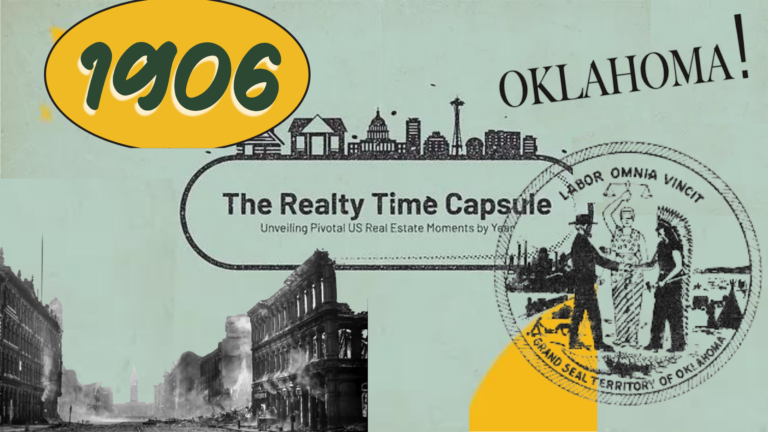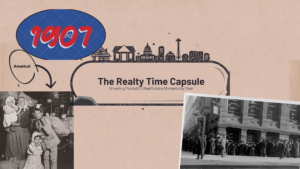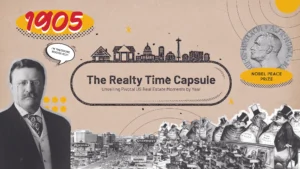
Introduction
Back in 1906, the United States was not a superpower. Great Britain still had its empire. France and Germany were rich and influential. Still, the U.S. was a rising nation, and everyone knew that it had so much potential. In this Realty Time Capsule, let’s take a closer look at the events that helped to shape 1906 and made the United States what it is today.
Three Key Points
1. Oklahoma Enabling Act: The Oklahoma Enabling Act was a major step towards the creation of the state of Oklahoma. The Act empowered those who lived in the Indian Territory and Oklahoma Territory to elect their own delegates to a state constitutional convention, which in turn would allow the two territories to be admitted into the union as a single state. The second part of the act then allowed those who were living in the New Mexico Territory and Arizona Territory at the time to form their own constitution and state governments.
Back in 1890, the Oklahoma Organic Act was proposed, and it aimed to accept the Oklahoma and Indian Territories as one state into the union. However, there was a move to have the Indian Territories become a separate state. This move was defeated, but President Theodore Roosevelt then me up with a compromise that would combine the two territories into one single state. All of that resulted in the Oklahoma Enabling Act.
The law was a landmark not just for the state of Oklahoma but for the states of New Mexico and Arizona as well, since it paved the way for their statehood.
2. The 1906 San Francisco Earthquake: On April 18, 1906, Northern California was struck by a major earthquake that had an estimated magnitude of 7.9. San Francisco was the most affected area, with fires immediately breaking out all over the city. More than 3,000 died because of the earthquake and the fires that it started. It is estimated that more than 80% of the city was destroyed. It is remembered as the deadliest earthquake in the history of the United States.
While the earthquake itself was quite devastating, the fires that it started were what really devastated the city. Ruptured gas mains caused the fires to spread quickly around the city, and in the end, more than 25,000 buildings were burned down. The fires caused an estimated damage of $350 million at the time, which in today’s money is equal to $8.9 billion.
Ironically, some of the fires were even started by the firefighters who used dynamite to blow up buildings in an attempt to create firebreaks.
Plans were immediately hatched to rebuild the city, although the funds were initially hard to come by. The original city street grid was restored, but there were definite improvements during the reconstruction, which resulted in an increase in real estate value in the city.
3. Osage Allotment Act: The Osage Allotment Act was passed in 1906, and it allotted the lands of the Osage Reservation to individual members of the Osage Nation.
The Osage Nation bought the land for their own reservation, which means they were able to retain more rights to it. They were able to retain the mineral rights to their land, which proved to be crucial later since it turned out that the lands were sitting on some of the richest oil deposits discovered back then.
The Osage Nation knew that there were many people who wanted to take advantage of them and their lands. This is why they sought that the mineral rights to their lands be held by the community. The oil leases and the royalties on the land would prove to be a windfall for the people of the Osage Nation, which turned them into some of the wealthiest people in the world on a per capita basis.
Headline Real Estate News Stories In 1906
President Theodore Roosevelt signed the Antiquities Act of 1906, which gave the President of the United States the power to set aside federal lands as national monuments by presidential proclamation. The aim is to protect features with historic, scientific, and natural significance. At that time looting of sites for artifacts was a real problem, one that threatened to destroy archeological sites. The law has been lauded since its enactment and served a significant purpose in protecting the heritage of the United States.
What Historic Real Estate Events Shaped 1906
The main historical event that shaped the real estate industry of the United States back in 1906 was the San Francisco earthquake, which devastated the city. The destruction that it caused meant that the city had to be rebuilt from scratch.
Economic Factors, Supply, and Demand
Gary, Indiana, was founded by the United States Steel Corporation in 1906. It is the location of the site of the Gary Works steel plant. The city was named after the founding chairman of the company. The plant was the largest in the world at that time, and it remains the largest integrated steel mill in the entire United States. It symbolized the rising industrial strength of the country, which would soon propel it to gain superpower status.
Demographic Factors
By 1906, the population of the United States had reached 85,450,000, which is a 1.94% increase from the previous year.
Societal Preferences and Trends
The first service is held at the African Methodist Episcopal Church in Los Angeles by W. J. Seymour, in a series later known as the Azusa Street Revival, an event that launched the Pentecostal movement in Christianity.
Environmental Factors
Mesa Verde was declared a National Park in 1906. The park is the site of some of the best-preserved Puebloan Ancestral sites in the United States.
Cultural Factors
When it comes to sports, 1906 was quite significant since it was the year that the Chicago White Sox won their First World Series, and they did it by defeating their crosstown rival Chicago Cubs 4 games to 2.
It was also the year that President Theodore Roosevelt proclaimed Devils Tower, Wyoming as the nation’s first National Monument.
Transportation and Infrastructure
When it comes to transportation, the Durham and Southern Railway operated its first revenue train in 1906.
Closing This Realty Time Capsule
1906 was another eventful year for the United States. It saw a steady march towards progress. While it was gaining power and influence, it was still far from the superpower that it would become it is today. For our next Realty Time Capsule, watch out for the things that would happen in 1907.
For a deeper understanding and look into these topics, check out these titles:
Oklahoma:
-
“The History of Oklahoma Hardcover” by Arrell M. Gibson






